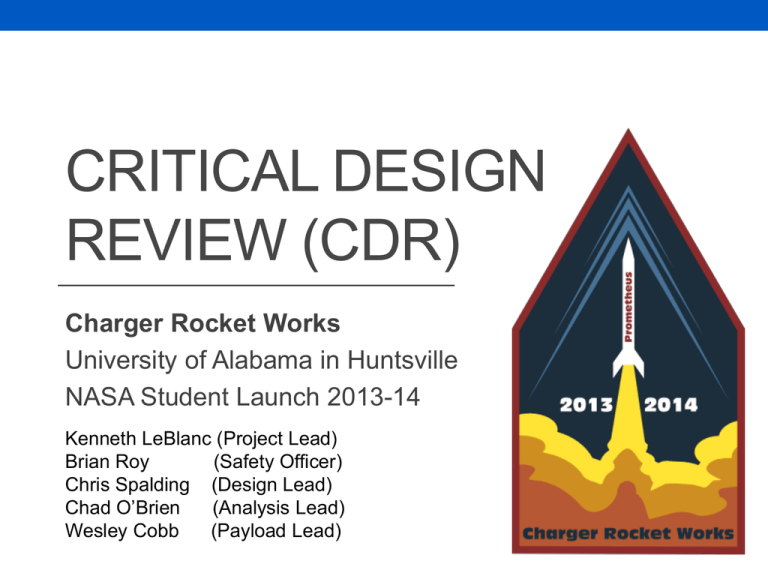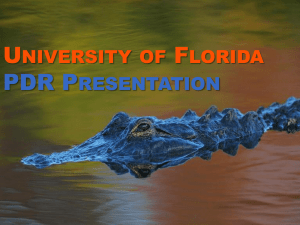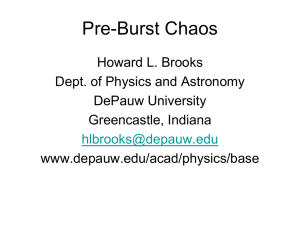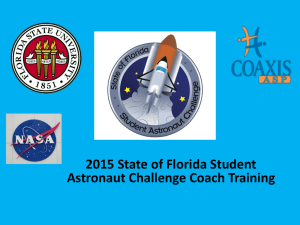UAH_2013-14_CDR_Presentation_NSL
advertisement

CRITICAL DESIGN REVIEW (CDR) Charger Rocket Works University of Alabama in Huntsville NASA Student Launch 2013-14 Kenneth LeBlanc (Project Lead) Brian Roy (Safety Officer) Chris Spalding (Design Lead) Chad O’Brien (Analysis Lead) Wesley Cobb (Payload Lead) 2 Prometheus Flight Overview Payload Description Nanolaunch 1200 Record flight data for aerodynamic coefficients Dielectrophoresis LHDS Supersonic Coatings Use high voltage to move fluid away from container walls Payloads Here Detect and transmit live data regarding landing hazards Test paint and temperature tape at supersonic speeds 3 Technology Readiness Level http://web.archive.org/web/20051206035043/http://as.nasa.gov/aboutus/trl-introduction.html 4 Outreach • Adaptable for different ages and lengths • Beginning outreach packet with Elementary School • Building the program from the ground up with school advisers • Supporting activity • Water Rockets • Completed • Science Olympiad • 102 Middle School • 54 High School • Scheduled • Challenger Elementary 5 On Pad Cost $15,820.91 System Propulsion $820.91 $408.00 $408.00 Recovery $15,506.94 Hardware Theoretical: $33.762 Actual: $2,362 $506.94 $2,026.98 $626.98 Payload $- $10,000.00 Cost $20,000.00 6 ANALYSIS 7 Analysis Responsibilities • Fin Flutter Analysis • RockSim/Open Rocket Trajectory Simulations • MATLAB 3DOF Simulations • Monte Carlo Simulations • FEA Analysis using MSC PATRAN and NASTRAN • CFD Analysis using CFD-ACE+ 8 Flight Trajectory • Max Altitude: 15800 ft • Max Velocity: 1600 ft/s, Mach: 1.45 • Acceleration: 40 G 9 Flight Trajectory 10 Flight Trajectory 11 Vehicle Aerodynamics – M4770 • Static Margin – 1.61 • CP – 92 in • CG – 84.4in • Thrust To Weight • Max Thrust – 1316 lbf • Average Thrust – 1073 lbf T2W: 40 T2W: 33.5 • Exit Rail Velocity – 122 fps 12 Final Motor Selection - CTI M4770-P • • • • ISP – 208.3s Loaded Weight: 14.337 lb Propellant Weight: 7.3 lb Max Thrust: 1362 lbf 13 Monte Carlo Analysis 14 Proof of Randomization in Inputs • Shows output consistency over multiple sets of simulations. 15 Drift Analysis 16 Variation in Flight Time • Time variance directly affects the radial landing distance. 17 CFD - Critical Mach Number *Steady state values Indicated by color maps 18 CFD – Aerothermal Heating *Steady state values Indicated by color maps 19 CFD - Drag vs Mach Plot • Uncertainty with Mach < 0.5 • Inadequate convergence in low Mach Regime 20 Plan B Motor: CTI-L890 Cross Wind 5mph 10mph 15mph 20mph 25mph Drift 900ft 1950ft 3050ft 4250ft 4700 ft Main Deployment Altitude 750ft 750ft 750ft 750ft 500ft 21 Recovery System • Single Separation Point • Main Parachute • Hemispherical • 12 ft • Cd 1.2 • Nylon • Drogue Parachute • Conic • 2.5 ft • Cd 0.71 (experimentally determined) • Nylon 22 Recovery System Deployment Process • Stage 1 • 2 seconds after apogee • nose cone separates • release the drogue • Stage 2 • 2.1 • Drogue attached via tethers. • 2.2 • A black powder charge separates the tethers • Stage 3 • Main parachute pulled from deployment bag Eye bolt L.H.D.S Tethers Black Powder Charge Drogue Main Parachute In Deployment bag 23 Deployment Process Stage 2.1 Stage 1: Drogue Deployment Stage 3 Stage 2.2 24 Energy and Velocity at Key Points 25 Sewing Technique • Seam Type: French Fell • Vent Hole supported with double stitched bias tapes • The bottom edge hemmed • Prevent fraying • Increase durability Stich Seam Cross Section 26 Subscale Drogue • Flight Test • Built by team • First attempt • Subscale Data • Perfect flight Altimeter • Cd of 0.71 • 27.5” Diameter 27 Construction Materials •Swivel ultimate load:1045 lbs •The nylon line anchor points ultimate load: 120 lbs per strap •The eyebolt ultimate load: 500 lbs 28 DESIGN 29 Hardware Team responsibilities: Design Details: • Vehicle design • 34lbs • Testing and verification of • 40Gs acceleration materials and components • Vehicle construction • Interfaces • Geometric similarity to NASA Nanolaunch protoype • Nanolaunch team requested maximum use of SLS printed titanium 30 Interfaces (1) # 1 Component Pitot probe Interface Method Threaded to nosecone shaft Load Locations Tension from pitot shaft, compression from nose cone, aerodynamic forces 2 Nosecone Slip fit with Shear Pins Compression from pitot probe and slip ring, aerodynamic forces 3 Nosecone Payload Threaded to nosecone shaft Acceleration forces, passed through nose cone shaft 4 Nosecone shaft Threaded to pitot probe Tension loads between the nose cone bulkhead and pitot probe, compression/ tension from payload acceleration forces 5 Nosecone Bulk head Slipped over payload shaft Tension from payload shaft/ ring nut Nose cone slip ring Slipped into body tube with shear pins, retained to nose cone with nose cone shaft Compression from nose cone and body tube, aerodynamic forces 6 Nosecone shaft nut Threaded to nosecone shaft Tension from payload shaft 7 Recovery package Shock cord / knot / ring nut Tension from ring nuts, aerodynamic forces 31 Interfaces (2) 8 Payload Slipped onto payload shaft/ constrained between nuts Acceleration forces, passed through payload shaft 9 Lower slip ring Held in compression between Compression from upper and lower body body tube sections with tubes, aerodynamic forces payload shaft 10 Payload shaft Threaded to motor case / lower Tension between bulkheads and ring nut, bulk head / ring nut compressive and tensile forces from payloads under acceleration 11 Centering ring Slipped onto payload shaft/ constrained between nuts Radial location of motor case; negligible forces 12 Motor case Threaded to payload shaft Outside manufacture; loaded in designed manner 13 Fins / Fin brackets Bolted to lower body tube/ T nuts inside body tube 14 Thrust ring Aerodynamic and acceleration forces, resulting tension from body tube Held in compression between Compression from motor case motor case and body tube 32 Thrust Ring • Printed titanium • Analyzed with FEA • Significantly stronger than required 33 Fin Assemblies • Modified significantly since PDR due to updated geometry from Nanolaunch team (bolted instead of epoxied) • Easier to inspect and verify • Fin replacement in the field now possible • Moderate weight penalty compared to original design. 34 Body Tube • Carbon composite • FEA, destructive testing and hand calculations done to assess strength • Large margin of safety and low weight 35 Payload Shaft • 7075-T6 Aluminum threaded shaft • Preloaded in tension • FEA and hand calculations show significantly over strength requirements 36 Payload Shaft Load Paths • Carries thrust loads into payloads and recovery forces into lower rocket, as well as providing assembly method for payloads, body tubes and recovery harness • Red Arrow indicates motor loads from thrust ring through body tube • Green arrow indicates motor loads passed through payloads • Blue arrow indicates recovery forces passed through payload shaft • Orange arrow indicates motor case retention force 37 Coupler Rings • Machined aluminum • Aft coupler retained by payload shaft preload • Fore coupler retained by nose cone shaft and shear pins 38 Nose Cone Assembly • All components retained by shaft similar to payload shaft • Carbon fiber nose cone shroud and bulkhead • Contains pitot pressure and accelerometer/ gyro data package 39 Pitot Probe • Allows measurement of static pressure along with supersonic AND subsonic total pressure • Unique and original design which could only be made with 3D printing techniques • Helps fulfill our Nanolaunch request to explore selective laser sintering in original ways. 40 Structure Testing • Carbon fiber dog bones • Loaded in tension • Verify tensile strength of materials • Tubes • Loaded in compression • Verify compressive strength of representative structures of body tube • 45/45 Sleeve • 0/90 Wrapped • Parachute Material • Loaded in tension • Verify parachute material and seam strength 41 Tension Results Fracture s Dog bones • Verified Strength Requirements • Fractures showed uniformity in the angle of the fibers • Calculated Young Modulus to be 309 ksi Fracture s Extension (in) Average Load vs. Extension 9.00E-02 8.00E-02 7.00E-02 6.00E-02 5.00E-02 4.00E-02 3.00E-02 2.00E-02 1.00E-02 0.00E+00 0 500 1000 Load (lbf) 1500 2000 Dog Bones Test Sample Failure Load (lbf) 1 1951.4 2 1785.3 3 1781.8 4 1732.8 5 1820.3 Average 1814.3 Standard Deviation 82.7 Max Extension (in) 0.086 0.074 0.068 0.064 0.084 0.075 0.010 42 Compression Results Tubes Fracture s • Wrapped tube holds the most force • Fractures showed uniformity in the angle of the fibers • Failure Load: 8094.5 (lbf) Load (lbf) Tube Compressive Strength 9000 8000 7000 6000 5000 4000 3000 2000 1000 0 Test Sample Sleeve Wrapped 40 50 60 70 Time (s) 80 90 100 Tubes Failure Load (lbf) Max Compression (in) 6226.1 0.139 8093.5 0.070 43 Parachute Results Seam Test • Seam failed before material • Breaking of seam occurred at 35 lbf • Narrow sample failed at seam due to edge effects Parachute Strength 45 40 35 Load (lbf) 30 Test Sample 1 2 25 20 15 10 5 0 0 20 40 60 80 Time (s) 100 120 140 Parachute Failure load (lbf) 35.71812 39.05464 Max Extension (in) 1.79 1.87 44 Structure Testing Conclusions Verified Requirements • Strength • Thickness • Fiber Angle • Fabrication Future Testing • Recovery system Dog Bones Test Sample Failure Load (lbf) 1 1951.4 2 1785.3 3 1781.8 4 1732.8 5 1820.3 Average 1814.3 Standard Deviation 82.7 Test Sample Sleeve Wrapped • Electronic payload • Verification of flight hardware • Flight testing completed rocket Test Sample 1 2 Max Extension (in) 0.086 0.074 0.068 0.064 0.084 0.075 0.010 Tubes Failure Load (lbf) Max Compression (in) 6226.1 0.139 8093.5 0.070 Parachute Failure load (lbf) 35.71812 39.05464 Max Extension (in) 1.79 1.87 45 Vehicle Requirements 46 PROCEDURES 47 Testing Procedures Review of Procedures by PRC Staff Develop Operating Procedures Test Requirement Identified Procedure Approval by PRC Director Identify Red Team Members for Test Review of Operating Procedure with Red Team Testing Approval of Red Team Members 48 Subscale Testing and Results Sub-Scale Flight Test Matrix Type of Test Test Goals Results Sub-Scale Flights Verify the vehicle stability margin and flight characteristics. Successful (2/8/14) Flight Electronics Ensure that payload records proper data and that launch detect functions properly. Partial Success (2/22/14) Recovery System Hardware Test hardware that will allow for a single separation dual deploy setup in full-scale vehicle. Partial Success (2/22/14) Parachute Design Verify construction techniques are adequate and determine effective drag coefficient. High Acceleration Flight (40+ G’s) Ensure that avionics will survive launch forces of full-scale. Success (2/22/14) Not Yet Tested 49 Recovery Hardware Testing CRW Built Parachute Deployment Bag Failure Point Separation Charges • Problems with deployment bag. • Successful proof of concept flight for parachute design. • Successful test of separation charges. 50 Subscale Flight Data • • • • • Apogee: 1,573 feet AGL. Max Velocity: 279 ft/s. Time of Flight: 63.9 seconds. Motor: CTI I-205. Recorded Using a PerfectFlite SL100 • • • • • Apogee: 4,156 feet AGL. Max Velocity: 597 ft/s. Time of Flight: 128.6 seconds. Motor: Aerotech I-600. Recorded Using a PerfectFlite SL100 51 PAYLOADS 52 Nanolaunch Experiment Overview L3GD20 • Calculating Aerodynamic Coefficients • Pitching moment Coefficient • Drag Coefficient 30 PSI • Measure base pressure • Two separate sensor packages • Accelerometers • Gyroscopes • Pressure sensors • Similar not identical ADXL345 Pressure Sensors ADXL377 ADC • Nosecone • Pitot probe • 60 PSI • 100 PSI • Near CG • Base pressure sensors • 30 PSI • Designed for future use CG Configuration 53 Nanolaunch Testing • Sensor Output • Ground tests - Breadboard • Calculated Pressure Sensor Gain • Tested Code Functionality • Sampling at 48 Hz per sensor • Subscale Flight – Data Extracted • Full Scale flight to Come • Will Include Pressure Sensors • EMI Testing • Test for EMI interference with sensors • Ground tests Subscale Payload Bay 54 Nanolaunch Payload Test Matrix • Tested Methodically • Successful Payload Data Extraction During Subscale Launch 55 Nanolaunch Success Criteria • Objectives: Meet Team/NASA SLI Requirements and Verify Those Were Met 56 Outcomes and Nanolaunch Path Forward • Outcomes: • Successfully Extracting Data • Preliminary Data/Results • Rocket Angular Velocity: Will be Calculated Based on Sign Change in Accelerometer Data • Path Forward • Record More Launch Data for Data Comparison • Create Data Buffer( To keep 30 seconds of data prior to launch detect) • Calibration of Sensors • Raise the ADXL345 Accelerometers to 16G setting. • Incorporate Amplified Pressure Sensors and ADC Into Circuit 57 Dielectrophoresis (DEP) • Fluid manipulation • Electric field • Peanut oil • Voltage • Voltage squared drives strength of electric field • Fluid • Dielectric constant determines fluid interaction • Electrode geometry • Gradient of electric field depends on geometry Uniform Electric Field Positive Region Negative Region 58 Experimental Changes • Electrode configuration: from parallel electrodes, to annular electrodes • Voltage increase from 7kV to ~12kV 2012-2013 Configuration 2013-2014 Configuration 59 DEP Testing • EMI Testing • Test next to flight ready recovery system • Minus gunpowder • Test next to Nanolaunch • Test and Prove design • Test revised circuit • Structure tests 60 DEP Success Criteria Requirement Microgravity environment Manipulate fluid with electric field Perform experiment without interfering with other payloads Recoverable and reusable Success Criteria Reach apogee of flight to experience microgravity environment Noticeable collection of fluid around central electrode Reliable data collection from all payloads adjacent to DEP Fluid containers intact. No electrical shorts. Functional electronics Verification Retrieve accelerometer data determine duration of microgravity environment Retrieve camera and accelerometer data Rigorous preflight testing .Post flight analysis of data. Recover the payload. Return to flight ready state with no repairs needed. 61 Supersonic Paints and Coatings • Urethane • Excellent retention • Abrasion resistant • Smooth Coating Urethane Epoxy • Epoxy Primer • Low film build • Excellent adhesion • Rough Coating • Thermal tape • 3-5 second reaction time • Changes color at specific temperatures • Excellent Adhesion Epoxy 62 SPC Testing • Oven Testing for Temperature tape • Calibration of tape • Temperature sensitivity • Reaction time • Flight Test • Subscale Test Flight • Full scale test launch 63 Success Criteria of Paints and Coatings 64 Landing Hazard Detection • Beaglebone • Camera cape • C++ libraries • Established knowledge base • 3 Methods of Analysis • Color detection • Edge detection • Shadow analysis • Grid analysis • Faster processing • Orientation • Use accelerometer to filter images of the ground 65 Radio • RF Module: XBee-PRO XSC S3B • 900 MHz transmit frequency • 20 Kbps data rate • 9 mile LoS range • 250 mW transmit power • 3.3 VDC supply voltage • 215 mA current draw • 1.5+ hr battery life at max sensor sample rate • Laptop ground station 66 GPS Tracking • GPS Module: Antenova M10382-Al • GPS lock from satellites • Transmits data through XBee RF module • 8 ft accuracy with 50% CEP • 3.3 VDC supply voltage • 22 to 52 mA current draw • Redundant GPS Unit: “Tagg Pet Tracker” • Supported by Verizon cell network • Smartphone based ground station • 25 ft accuracy with 95% confidence • Self-contained power source • 3.5+ days battery life 67 LHDS Testing • Test Flights • Full scale only • Alter method for different launch field • Bench Test • White wall simulates salt flats • Colored paper as “hazards” • Google Map images Hera Launch Field Manchester, TN Bonneville Salt Flats, UT 68 LHDS Success Criteria Requirement Success Criteria Verification Transmit LHDS data in real time to a ground station. Data is sent from RF module aboard rocket to ground station without loss or corruption. Transmitted data is received by ground station. Data is verified using either Checksums or postflight data comparison. The payload shall be recoverable and reusable. Recover the RF module and reuse it. The RF module is recovered and can be launched again on the same day. Transmit live GPS Data RF module transmits live GPS data from the GPS module to the ground station. GPS location of the rocket is received by the ground station. The electronic tracking device shall be fully functional during the official flight at the competition launch site. GPS data is sent through RF GPS location data from the module aboard the rocket to the rocket is received by the ground ground station during the station during the official flight at competition launch. the competition. 69







